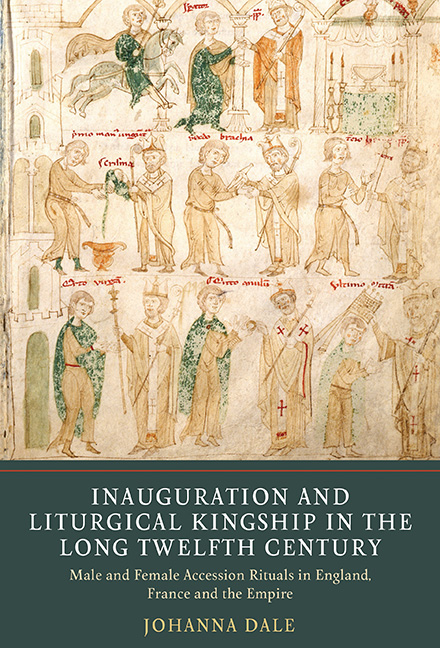 Inauguration and Liturgical Kingship in the Long Twelfth Century
Inauguration and Liturgical Kingship in the Long Twelfth Century Book contents
- Frontmatter
- Contents
- List of Illustrations
- Acknowledgements
- List of Abbreviations
- Timeline
- Genealogies
- Introduction
- 1 Liturgical Texts: The Spoken Word and Song
- 2 Liturgical Rituals: Rubrication and Regalia
- 3 Who and Where? Actors, Location and Legitimacy
- 4 What and When? Consecration and the Liturgical Calendar
- 5 Royal Titles, Anniversaries and their Meaning: The Charter Evidence
- 6 Seal Impressions and Christomimetic Kingship
- Conclusion
- Appendix 1 Editions and Manuscripts of the Selected Ordines
- Appendix 2 Prayer Formulae Incipits
- Appendix 3 Tables of Ritual Elements in the Ordines
- Appendix 4 Brief Descriptions of Royal and Imperial Seals and Bullae
- Bibliography
- Index of Biblical References
- General Index
3 - Who and Where? Actors, Location and Legitimacy
Published online by Cambridge University Press: 25 October 2019
- Frontmatter
- Contents
- List of Illustrations
- Acknowledgements
- List of Abbreviations
- Timeline
- Genealogies
- Introduction
- 1 Liturgical Texts: The Spoken Word and Song
- 2 Liturgical Rituals: Rubrication and Regalia
- 3 Who and Where? Actors, Location and Legitimacy
- 4 What and When? Consecration and the Liturgical Calendar
- 5 Royal Titles, Anniversaries and their Meaning: The Charter Evidence
- 6 Seal Impressions and Christomimetic Kingship
- Conclusion
- Appendix 1 Editions and Manuscripts of the Selected Ordines
- Appendix 2 Prayer Formulae Incipits
- Appendix 3 Tables of Ritual Elements in the Ordines
- Appendix 4 Brief Descriptions of Royal and Imperial Seals and Bullae
- Bibliography
- Index of Biblical References
- General Index
Summary
Roger of Howden provides a detailed description of a procession which arrived at the doors of Westminster Abbey on 3 September 1189. In the vanguard were clerics carrying holy water, crosses, candles and thuribles, closely followed by priors, then abbots, then four barons carrying four golden candlesticks processing amongst the bishops. Godfrey de Lucy and John Marshal followed side by side, Godfrey carrying a felt cap and John a large pair of heavy spurs made of gold. Then came William Marshal, here described as earl of Striguil, with a golden sceptre topped by a cross, accompanied by William FitzPatrick, earl of Salisbury, carrying a golden rod decorated with a golden dove. Then came the triumvirate of David, earl of Huntingdon, John, count of Mortain, and Robert, earl of Leicester, each bearing a sword from the royal treasury. Behind them came six earls and nobles carrying the royal insignia and clothing, then William de Mandeville, count of Aumale, bearing a large and weighty golden crown, decorated with precious stones. Finally came Richard, duke of Normandy, flanked by Hugh, bishop of Durham to his right and Reginald, bishop of Bath to his left. The duke, under a silken canopy, held aloft by four barons, entered the abbey in which he was to be transformed from a duke into a king. His transformation is echoed in the language used by Roger of Howden. Richard arrived at the cathedral as dux Normanniae. Following his anointing, crowning and investiture with the objects carried in procession by his barons, he departed Westminster as dominus rex. Roger continues his account to tell us that the king swapped his coronation crown for a lighter version and that, ‘thus crowned he came to eat, and the archbishops and bishops sat with him on one table, each seated according to his order and dignity. The earls and barons served in the royal household just as their dignities demanded. The citizens of London served in the buttery and the citizens of Winchester in the kitchen.’
Roger's account is suffused with the language of rank. Richard's rank had been enhanced. The churchmen took their places at the king's table according to their order and dignity.
- Type
- Chapter
- Information
- Inauguration and Liturgical Kingship in the Long Twelfth CenturyMale and Female Accession Rituals in England, France and the Empire, pp. 105 - 129Publisher: Boydell & BrewerPrint publication year: 2019


